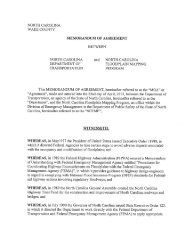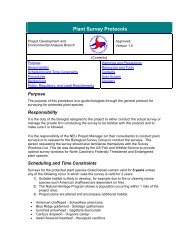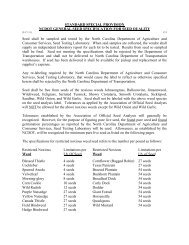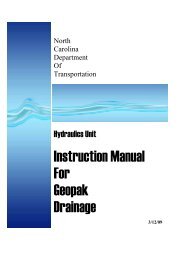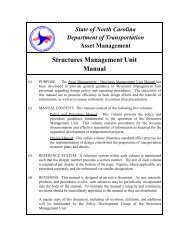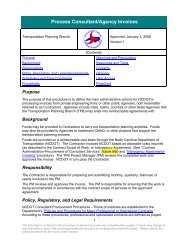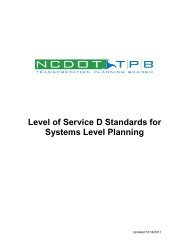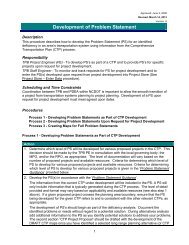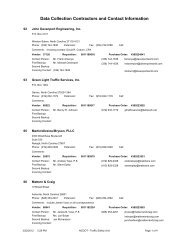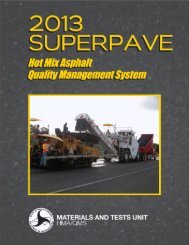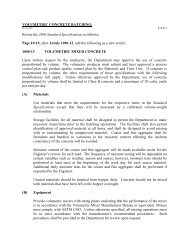Guardrail Committee Minutes - Connect NCDOT
Guardrail Committee Minutes - Connect NCDOT
Guardrail Committee Minutes - Connect NCDOT
You also want an ePaper? Increase the reach of your titles
YUMPU automatically turns print PDFs into web optimized ePapers that Google loves.
<strong>Guardrail</strong> <strong>Committee</strong> <strong>Minutes</strong><br />
January 18, 2007<br />
10:30 AM<br />
Roadway Design Conference Room<br />
I. Quick items to address from the last meeting’s “To Do” List<br />
♦ Amount of Prime Coat called for on Standard Drawing 862.01 (Sheet 10<br />
of 11) (Joel Howerton)<br />
Joel Howerton spoke with Mr. Clark Morrison in regards to this<br />
standard drawing. Mr. Morrison’s recommendation to address concrete<br />
shoulders is to place 4” of ABC with a Straight Seal. Warren Walker<br />
was concerned with the cost associated with performing this<br />
operation. Another concern was how would we make sure the quantity<br />
calculations were accounted for in our projects. It was the general<br />
consensus of the <strong>Guardrail</strong> <strong>Committee</strong> that the best way to address<br />
concrete shoulders would be to place a note on the standard noting<br />
that a special detail would be required for concrete shoulders. For<br />
asphalt shoulders, Jay Bennett recommended that we investigate using<br />
the surface course for the top layer. Joel Howerton will check with<br />
Clark Morrison to make a determination on how best to revise this<br />
standard. Joel will provide a copy of the new special detail sheet<br />
to be used in lieu of this standard at our next committee meeting.<br />
♦ NP-06-4604 – T31/39 <strong>Guardrail</strong> by Trinity Highway Safety Products Inc<br />
(Joel Howerton)<br />
Joel noted that this product would save some grading and that it is<br />
a proprietary product. Therefore, it should not be treated as a new<br />
product. To use this product will require special approval. Joel<br />
has discussed the usage of this product with the New Products<br />
<strong>Committee</strong>.<br />
♦ Letter (dated November 29, 2006) to add additional guiderail post<br />
(Attachment 1)<br />
Ron Allen briefly reviewed a copy of the subject letter. No further<br />
comments were noted.<br />
♦ Field Inspection Questions to address what design measures to use on<br />
dead-end roadways (Attachment 2)<br />
A copy of the Combined Field Inspection Questions was attached for<br />
attachment 2. Roger Thomas reviewed the two questions that<br />
addressed the placement of guardrail/terminal treatments on<br />
dead-ended roadways. Dennis Jernigan noted that he would send out a<br />
bulletin to the Construction Unit and make them aware that they need<br />
to review the roadway plans closer to make sure they address what<br />
measures to use on dead-ended roadways.<br />
1
<strong>Guardrail</strong> <strong>Committee</strong> Meeting<br />
January 18, 2007<br />
II.<br />
Potential issues with the recent release of AASHTO Roadside<br />
Design Guide Chapter 6 Update; specifically to the 6.6.1<br />
Terrain Effects section.<br />
Kevin Lacy and Shawn Troy presented their findings in regards to this recent<br />
release. Shawn passed out documentation that summarized their concerns. He<br />
also passed out a table which showed both Frontside and Backside cable<br />
guiderail breach information.<br />
Kevin Lacy gave a brief history of how the AASHTO Subcommittee coordinated<br />
with George Washington University during the development of the update for<br />
chapter 6, section 6.6.1 Terrain Effects. The Transportation Engineering<br />
Safety Systems Branch (TESSB) has concerns with the new guidelines, because<br />
it appears to be based off limited simulation and minimal crash testing. The<br />
AASHTO Subcommittee is recommending that the new guidance apply to all cable<br />
barriers, including high-tension designs and 4-cable systems. Basically, it<br />
recommends that maximum redirection with cable barrier can be achieved if the<br />
area from 1 ft to 8 ft from the ditchline on a 1V:6H slope is avoided. The<br />
final draft is in circulation.<br />
The TESSB would like to respond back to AASHTO in regards to the Chapter 6<br />
Update. They noted that <strong>NCDOT</strong> was the only data providers to assist George<br />
Washington University with input data for their research. Furthermore, they<br />
noted that there have been no crash tests performed with an eight foot offset<br />
from the centerline of median. They also noted that based upon frontside hit<br />
data information that more research needs to go into address frontside<br />
penetrations. The TESSB thinks it is too early to make this section of the<br />
new update a national standard guideline. The Chapter 6, 2006 update of the<br />
Roadside Design Guide (2002) has been released through AASHTO. Following the<br />
release, the Department continues to place cable guiderail that does not meet<br />
this new guidance. Therefore, we will need to coordinate with the Attorney<br />
General’s Office on how to best document our placement policy. A letter will<br />
likely need to be prepared for either Kevin Lacy’s or Debbie Barbour’s<br />
signature.<br />
Shawn Troy noted that we have a 3-year crash history and documentation for<br />
areas where we have placed different types of median barrier. Shawn<br />
questioned, “What is an acceptable rate of penetration?”<br />
III. Follow up to Depressed Median <strong>Guardrail</strong> Issues with Divided<br />
Highways of 6 Lanes or more.<br />
The <strong>Guardrail</strong> <strong>Committee</strong> Reviewed two new Special Details developed by Garry<br />
Lee and Virginia Mabry to address median barrier placement for both 46 and 60<br />
foot medians with three or more travel lanes in each direction. The 46-foot<br />
median detail showed the placement of two lines of steel beam guardrail with<br />
the face of the guardrail lining up with the shoulder edge of pavement.<br />
While the 60 foot median detail showed a single line of cable guiderail<br />
offset from the centerline of the median ditch 8 feet. In regards to the<br />
46-foot median detail, Garry Lee recommended that we investigate the<br />
2
<strong>Guardrail</strong> <strong>Committee</strong> Meeting<br />
January 18, 2007<br />
likelihood of making all the median slopes 4:1. This would aid with positive<br />
pavement drainage.<br />
A subcommittee will be formed to address what design measures should be taken<br />
to address positive pavement drainage with a 46-foot median divided facility<br />
and 12 foot inside paved shoulders. Also, Garry Lee will look into what<br />
updates may need to be made to the Design Manual to address positive pavement<br />
drainage and the median barrier placement with 6 lanes or more.<br />
The results from a poll taken of Roadway Design Project Engineers to<br />
determine how many projects are in the unit that have 6 or more travel lanes<br />
with a 46 foot median was compiled by Roger Thomas. Five out of a total of<br />
13 Project Engineer groups have projects at various stages (preliminary and<br />
right of way plan stage) with this typical section. There are a total of 9<br />
projects unit wide with this proposed typical section. Five projects are at<br />
the Preliminary design stage and four are at the Right of Way Plan<br />
development stage.<br />
III. Miscellaneous<br />
♦ Ron Allen noted we need to have a field trip to look at the cable<br />
guiderail and guardrail placement on recently constructed projects.<br />
For instance, the placement of cable guiderail on recently completed<br />
sections of I-540 was suggested.<br />
♦ Garry Lee noted the Roadway Design Unit and Traffic Control Unit<br />
need to coordinate better in making a determination on whether<br />
gating or non-gating impact attenuators will be required. One<br />
possible way to address this concern is to revise the Pre-Let Field<br />
Inspection Questions to incorporate a question that addresses this<br />
issue and to make sure Mr. Stuart Bourne is cc’d.<br />
To Do List<br />
• Joel Howerton will coordinate with Clark Morrison on how to revise<br />
Standard Drawing 862.01 (sheet 10 of 11). Joel will provide a copy of the<br />
new special detail sheet at our next committee meeting.<br />
• Kevin Lacy will coordinate with Jay Bennett on how to address the recent<br />
release of the AASHTO Roadside Design Guide Chapter Six, section 6.6.1<br />
Terrain Effects Section update.<br />
• Scott Blevins, Roger Thomas, Cynthia Perry, Garry Lee and Clark Morrison<br />
will meet to discuss what design measures should be taken to address<br />
positive pavement drainage with a 6 lane, 46-foot median divided facility.<br />
• Garry Lee and Roger Thomas will develop a new Pre-Let Field Inspection<br />
Question to address if gating or non-gating impact attenuators are<br />
required due to temporary traffic patterns.<br />
<strong>Minutes</strong> prepared by Roger Thomas, PE<br />
<strong>Minutes</strong> approved by Ron Allen, PE<br />
3



